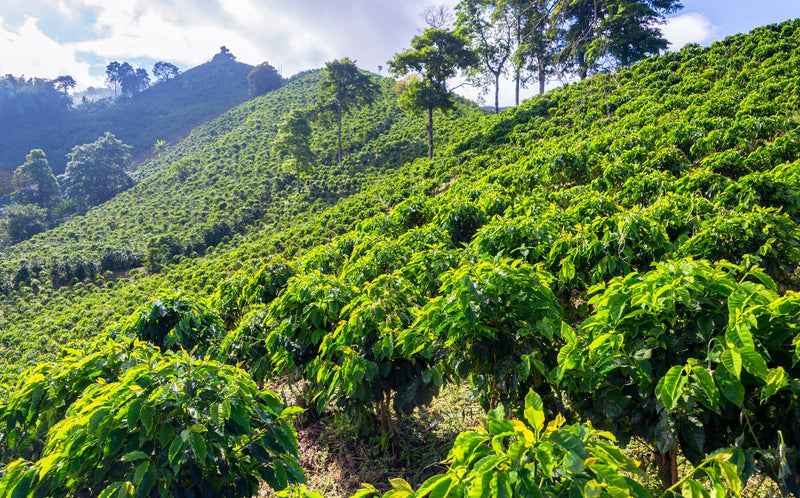Coffee cultivation
The coffee cultivation is widespread in different parts of the world, but there are some countries that stand out for their significant and high quality production. These countries are located primarily within a belt known as the "Coffee Belt", which encircles the equator .
The Coffee Belt is characterized by a tropical and subtropical climate, with moderate temperatures and abundant rainfall, ideal conditions for the growth of coffee plants.
Let's see some of the main coffee producing countries within the Coffee Belt:
Brazil is the largest producer of coffee in the world and offers a wide range of varieties. Its main producing regions include Minas Gerais, Sao Paulo and Espirito Santo. Brazil is known for its full-bodied, sweet-tasting coffees, often used in espresso blends.

Colombia is renowned for the quality of its arabica coffee. Mountainous regions such as Diecio, Antioquia and Huila offer ideal altitude and climate conditions for cultivation. Colombian coffees are appreciated for their sweetness and balanced acidity, with notes of chocolate and fruit.

Ethiopia is the place of coffee's historical origin and boasts a great diversity of varieties. Ethiopian coffees are known for their floral and fruity aromas, with a great complexity of taste. The regions of Sidamo, Yirgacheffe and Harrar are renowned for their high quality coffees.

Vietnam is the second largest producer of coffee in the world, with an emphasis on the production of Robusta coffee. This type of coffee has a stronger flavor and fuller body than Arabica. Dak Lak Province is the main coffee producing region in Vietnam.

Guatemala is appreciated for its high quality coffees, known for their complex aromas but at the same time delicate. The regions of Antigua, Santa Rosa, Huehuetenango and Cobán produce some of the best Guatemalan coffee. The volcanic soils and high altitude give Guatemalan coffees a distinctive character.

In addition to these main countries, there are many others in the Coffee Belt that contribute to global coffee production, such as Costa Rica, Kenya, Honduras, Peru, Mexico, just to name a few. Each country has its own varieties, cultivation methods and climatic influences which are reflected in the quality and in the character of the coffee they grow. This diversity of origin is what makes the world of coffee so fascinating and full of discoveries for lovers of this extraordinary drink.
In addition to geographic region, there are numerous factors that influence coffee cultivation.Here are some of the key elements:
Climate: icoffee requires a specific climate to grow successfully. moderate temperatures, between 20°C and 28°C, are ideal for coffee plants. Seasonal variations in climate, such as dry and wet seasons, can affect flowering, coffee cherry ripening and bean quality.
Altitude: the altitude at which coffee is grown has a significant impact on its quality and flavor. Coffee plants grown at higher altitudes tend to grow slower and produce denser beans, which often results in a more complex flavor and higher acidity. On the other hand, coffee grown at lower altitudes can have a sweeter, fuller-bodied taste.
Soil: the soil in which coffee is grown plays a fundamental role in its growth. Well-drained soils, rich in nutrients such as nitrogen, phosphorus and potassium, provide a favorable environment for the roots of coffee plants. Furthermore, some volcanic or mineral-rich soils can give coffee unique characteristics and highlight certain flavor profiles.
Water: Water is essential for growing coffee. Coffee plants require an adequate amount of water during their growth cycle, but excessive humidity or insufficient watering can negatively affect the quality of the coffee. The balance between soil moisture and irrigation is essential to ensure good production.
Sunlight: coffee plants need adequate sunlight for photosynthesis and good fruit production. Exposure to long hours of sun can contribute to good ripening of coffee cherries, influencing the sugar and acid content in the bean.
Agricultural practices: Theagricultural practices adopted during coffee cultivation can affect its quality. The use of sustainable methods such as shade cultivation, which protects plants from excessive sunlight, or organic farming , which avoids the use of harmful chemicals, can improve the taste profile of coffee and preserve the surrounding environment.
Coffee varieties: andthere are numerous varieties of coffee, each with its own unique flavor characteristics and adaptability to different growing conditions . Some of the most common varieties include Arabica and Robusta. The Arabica variety is considered high quality, with a more refined taste and balanced acidity. The Robusta variety, on the other hand, has a stronger flavor and a fuller body. Choosing the right variety based on climatic conditions and soil can greatly influence the quality of the coffee. For further information, read this article on the Arabic and Robusta varieties.
Processing: the processing process of the drupes after harvesting can influence the final flavor of the coffee. There are several methods of processing, including the wet method (washed) and the dry method (natural). Each method can give the coffee different aromas and taste characteristics. For example, washed coffee tends to have greater cleanliness and brightness, while natural coffee can have notes of fruit and more pronounced sweetness.
Roasting: finally, the roasting process has a significant impact on the formation of the flavor of the coffee. The duration and intensity of the roast can influence the aromatic complexity, acidity, body and bitterness of the coffee. Different roasting nuances, such as light, medium or dark roast, can highlight different characteristics of the coffee.
In conclusion, coffee cultivation is a complex process influenced by several factors. Producing countries located in the Coffee Belt take advantage of ideal climatic and geographic conditions to grow high-quality coffee. However, elements such as altitude, soil, water, sunlight, agricultural practices, coffee varieties, processing and roasting also contribute to defining the taste profile and the final quality of the drink that we love so much. The art of coffee cultivation is a mix of science, experience and passion which translates into a unique and exceptional cup of coffee.

